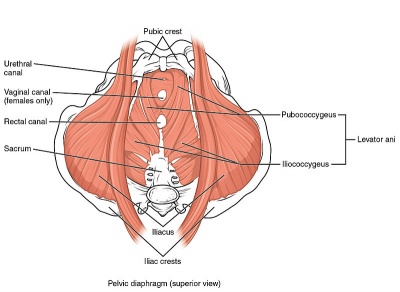Vulvar Hygiene
This article is currently under review and may not be up to date. Please come back soon to see the finished work! (30/04/2019)
Definition[edit | edit source]
Definitions:[1]
- Vulva: the external female genital area
- Labia majora: the outer folds of skin
- Labia minora: the inner folds of skin
- The vestibule surrounds the opening of the vagina
Physiology of the vulvovaginal area:[2]
Vulvar skin differs from other skin sites because of its increased hydration, occlusion, and frictional properties, and it is more susceptible to topical agents.[2] The vulva is the first line of defense to protect the genital tract from infection. The normal vaginal flora, acidic vaginal pH, and vaginal discharge are all components to maintain the health of the vulvovaginal region. Estrogran promotes the growth of lactobacilli, which is a bacterial in the vagina that has several important functions. This bacteria maintains a slightly acidic environment in the vagina, reducing the likelihood of infections.[2][1]
Clinically Relevant Anatomy[edit | edit source]
Please see the page "Pelvic Floor Anatomy," for further details regarding anatomy.
Importance of Educating Patients on Vulvar Proper Care[edit | edit source]
There are numerous products on the market targeting women and the vulvar region. Women's daily cleansing routine are impacted by many factors, including personal preference, cultural norms, religious practices, and guidance from health care professionals. It is important as health care professionals who interact with this population to educate on the topic of proper vulvar care. Some of the products and cleansing routines may actually cause harm opposed. Intimate hygiene products for cleanliness and odor control for example, but may upset pH in the vulvovaginal area, which will affect the composition of the normal vulvovaginal microbiota needed for protection against infection. Additionally, vaginal douching has also been associated with an increased risk of pelvic inflammatory disease, endometriosis, and sexually transmitted infections. [2]
Irritation in the vulvar region can contribute to:
- dyspareunia
- interstitial cystitis
- yeast infections
- bacterial vaginosis
- urinary tract infection
- increased itching
Vulvar Care[edit | edit source]
Clothing and Laundry[3]
- Wear all-white cotton underwear
- Do not wear pantyhose (wear thigh high or knee high hose instead)
- Wear loose-fitting pants or skirts
- Remove wet bathing suits and exercise clothing promptly
- Use dermatologically approved detergent such as Purex or Clear
- Double-rinse underwear and any other clothing that comes into contact with the vulva
- Do not use fabric softener on undergarments
Hygiene[3]
- Use soft, white, unscented toilet paper
- Use lukewarm or cool sitz baths to relieve burning and irritation
- Avoid getting shampoo on the vulvar area
- Do not use bubble bath, feminine hygiene products, or any perfumed creams or soaps
- Wash the vulva with cool to lukewarm water only - the vagina is self cleansing and does not require soap
- Rinse the vulva with water after urination
- Urinate before the bladder is full
- Prevent constipation by adding fiber to your diet (if necessary, use a psyllium product such as Metamucil) and drinking at least 8 glasses of water daily
- Use 100% cotton menstrual pads and tampons
Sexual Intercourse[3]
- Use a lubricant that is water soluble, e.g., Astroglide
- Urinate (to prevent infection) and rinse vulva with cool water after sexual intercourse
- Do not use contraceptive creams or spermicides
Physical Activity[3]
- Avoid exercises that put direct pressure on the vulva such as bicycle riding and horseback riding
- Limit intense exercises that create a lot of friction in the vulvar area (try lower intensity exercises such as walking)
- Use a frozen gel pack wrapped in a towel to relieve symptoms after exercise
- Enroll in an exercise class such as yoga to learn stretching and relaxation exercises
- Don’t swim in highly chlorinated pools
- Avoid the use of hot tubs
Resources[edit | edit source]
The American College of Obstetricians and Gynecologists: FAQ on Vulvovaginal Health
References[edit | edit source]
- ↑ 1.0 1.1 The American College of Obstetricians and Gynecologists. Vulvovaginal Health. Available from: https://www.acog.org/Patients/FAQs/Vulvovaginal-Health
- ↑ 2.0 2.1 2.2 2.3 Chen Y, Bruning E, Rubino J, Eder SE. Role of female intimate hygiene in vulvovaginal health: Global hygiene practices and product usage. Women's Health. 2017 Dec;13(3):58-67.
- ↑ 3.0 3.1 3.2 3.3 National Vulvodynia Association. Self help tips. Available from: https://www.nva.org/for-patients/self-help-tips/







